Are Bombay Cats Friendly: Get to Know Your Bombay Cat
Yes, Bombay cats are known for being friendly and affectionate. They are often described as being “dog-like” in their behavior, as they are known to be very social and enjoy spending time with their human companions. They are known for being playful and curious and enjoy interacting with their owners; they are also very vocal and may “talk” to their owners using meows.
Table of Contents
Bombay Cat Characteristics
Sociable and Outgoing
According to ASPCA Pet Health Insurance, Bombay cats are generally known to be friendly and outgoing and do well in households with other cats and dogs. They are known for being friendly and affectionate and enjoy spending time with their human companions. They are also known for being playful and curious, which can make them great companions for children and other pets.


However, it is essential to note that each cat can have its personality and temperament, and some may be more shy or aloof than others. It’s also important to remember that introducing any new pet to a household with other cats and dogs will require proper introduction and monitoring.
Affectionate
Bombay cats are known for being affectionate and easy to care for pets. They are known for their friendly and social personalities and make great companions for people looking for a cat that is easy to get along with. They are playful and curious and enjoy spending time with their human companions.
Loyal
Bombay cats can be loyal companions, and many owners report that their cats follow them around the house, greet them at the door, and even sleep with them. They also enjoy being petted and cuddled and are known to be very vocal, often “talking” to their owners with meows, chirps, and other sounds.
Tolerant
Bombay cats are generally tolerant of other pets and children in the household. They are good at adapting to new situations, making them ideal cats for households with different breeds of cat personalities. These cats are known for their playful personalities and are commonly seen playing fetch or napping.
Independent
Some Bombay cats may be more independent, while others may be more affectionate and clingy. It also depends on your bond and relationship with your cat, how you raise and train it, and the environment where it is raised.
Playful
Bombay cats are playful and friendly cats that make great house pets. They are good with children and other animals, making them an ideal choice as a family cat or cat breed.


Bombay cats are known for their playful personalities, so providing them with plenty of toys and scratching posts is essential. These cats can be easily trained to follow basic commands such as “sit” and “stay” if you care to train them. They make an excellent family cat, especially if you have kids at home. These gentle and intelligent cats are easy to care for and make an excellent addition to any household.
Sensitive
Bombay cats are sensitive to the emotions and moods of their human companions. They are known to be very wise and can sense when their owner is upset or stressed, and they may try to comfort them. They are also known to be very expressive and can communicate their own emotions through their body language and vocalizations.
Aggressive
While some Bombay cats may have a more assertive or independent personality, they are not generally known for being aggressive. They are generally known for being friendly, affectionate, and social cats.
Bombay cats can have their personalities and behavior like any other cat breed. It is not uncommon for some cats to be more assertive or independent than others, but this does not mean they are aggressive.
It’s important to remember that various factors, such as fear, pain, or lack of socialization, can cause cat aggression. For example, if a cat is displaying aggressive behavior, it’s essential to consult a veterinarian or a professional behaviorist to rule out any underlying medical or behavioral issues.
Intelligent
Bombay cats are known for their intelligence. They are typically easy to handle and require little maintenance. Their intelligence also makes them easy to train. They are known to be responsive to positive reinforcement training methods, such as treats and praise, and can be trained to do various tricks, such as fetching, playing hide-and-seek, and even using the toilet.
Talkative
Bombay cats are known to be quite vocal and talkative. They are known to express themselves through various meows, chirps, and other sounds, and they enjoy “talking” to their owners. They are also known to be very expressive and communicative with their body language and facial expressions.
Curious
Bombay cats are known to be quite curious. They are known to be very active and playful, and they enjoy exploring their surroundings. They are also very curious about new people, animals, and objects and enjoy investigating and exploring new things.


Bombay cats are known to be very intelligent and independent, and they enjoy problem-solving and figuring out new puzzles. They are also known to be very agile and athletic, and they enjoy climbing and jumping.
Tricks to Teach Your Bombay Cat
- Sit: Start with a treat in your hand, hold it in front of your cat’s nose, and slowly raise it up and over its head. Their bottom will naturally lower to the ground as they look up to follow the treat. Once they are sitting, please give them the treat and praise them.
- Come: Call your cat’s name and use a treat or toy to encourage them to come to you. Once they reach you, please give them a treat and praise them.
- Shake: Hold a treat or toy in front of your cat’s nose, then move it up and down. When your cat lifts their paw to swipe at the treat, say “shake” and give them the treat.
- High five: Hold a treat or toy in front of your cat’s nose and wait for them to raise its paw. Once they do, say “high five” and give them the treat.
- Roll over: Hold a treat or toy in front of your cat’s nose and slowly move it across the floor. As your cat follows the treat, say “roll over” and gently guide them onto their side. Once they are lying down, please give them the treat and praise them.
- Fetch: Use a small toy or ball and throw it quickly. Encourage your cat to bring the toy back to you. Reward them with a treat when they bring the toy back.
- Toilet training: You can train your cat to use the toilet by moving its litter box closer to the toilet. Once they get used to the new location, remove the litter and place a litter tray on the toilet seat.
